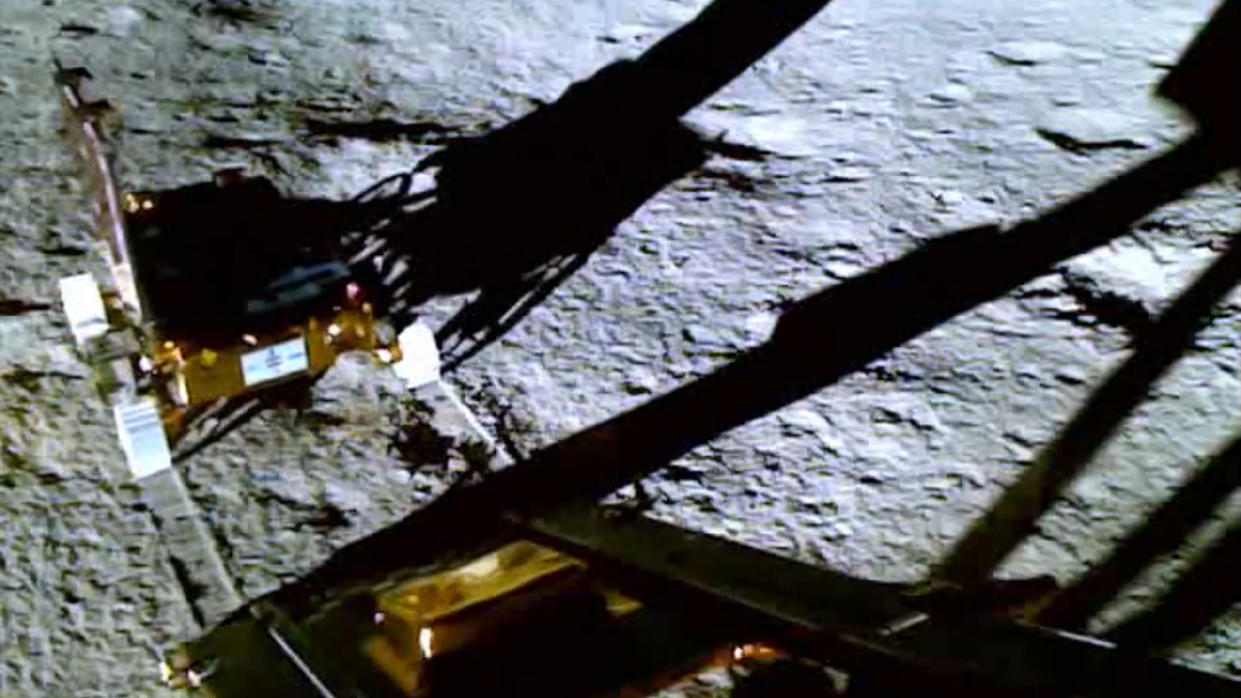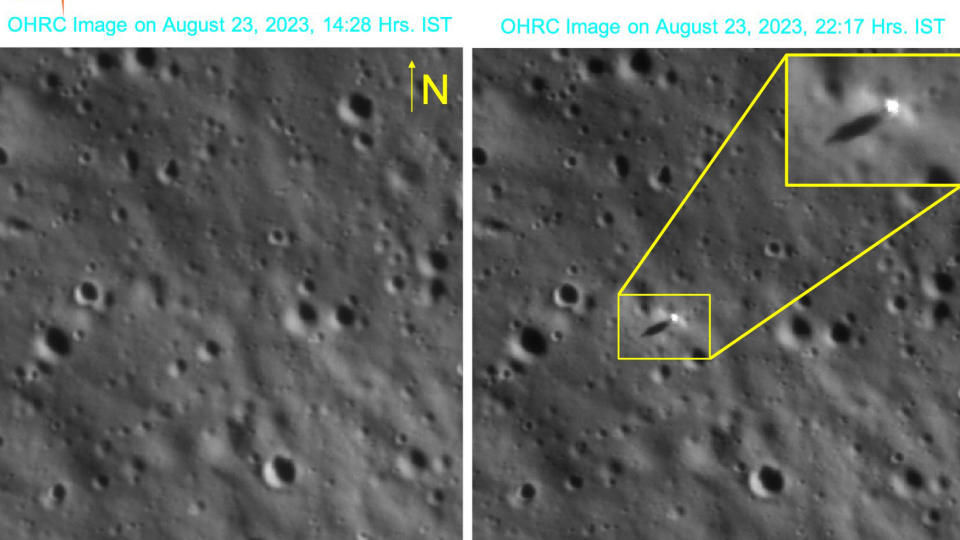Watch Chandrayaan-3's Pragyan rover take its '1st steps' on the moon (video)

The Indian Space Research Organization just shared a video capturing the moment when Chandrayaan-3's Pragyan rover "stepped onto" the moon's surface for the first time — as well as the first image of the rover and the mission's lander taken from orbit.
Although the Pragyan rover disembarked from the landing platform on Wednesday (Aug. 23), at about 11 p.m. EDT (0300 GMT on Thursday, Aug. 24), the Indian Space Research Organization (ISRO) only released the footage capturing the historic moment about a day later.
The footage, taken by a camera on Chandrayaan-3's Vikram (Sanskrit for "valor") lander, shows Pragyan ("wisdom") with its vertical solar panel deployed like a sail rolling down the ramp and leaving tracks in the soft lunar dust as its wheels touch it for the first time.
A separate clip shows the preceding sequence of events with the lander's ramp door opening, revealing the rover stowed inside and the subsequent deployment of the solar panel.
Related: Why Chandrayaan-3 landed near the moon's south pole

"A two-segment ramp facilitated the roll-down of the rover," ISRO said in a post on X, previously known as Twitter, sharing the clips. "A solar panel enabled the rover to generate power."
ISRO added that 26 mechanical segments — all developed at the Rao Satellite Centre in Bangalore, India's tech center and capital of the southern state of Karnataka — were needed to facilitate the smooth release of the rover from the lander.
Later in the day, ISRO announced that Pragyan has already traversed a distance of about 26 feet (8 meters) and that all systems on both, the lander and the rover are fit and well.
ISRO also shared a photo of Pragyan and its mothership sitting next to each other on the lunar surface, which was taken from the moon's orbit by another Indian mission, the Chandrayaan-2 orbiter.
"Chandrayaan-2's Orbiter High-Resolution Camera (OHRC), the camera with the best resolution anyone currently has around the moon, spots Chandrayaan-3 Lander after the landing on 23/2³/23," ISRO said in a post on X, referring to the day (August 23), year (2023) and time (nearly 11 pm, or 2300) when the image was taken.

The Chandrayaan-2 mission was Chandrayaan-3's predecessor and India's first attempt to land on the moon. That attempt, however, failed in September 2019 due to a software glitch.
Landing on the moon is notoriously difficult. With the successful touchdown of Chandrayaan-3, India has joined a handful of countries that have accomplished that feat — the United States, Russia and China.
Earlier this year, an attempt by the Japan-based company ispace failed when its Hakuto-R lander hit a crater rim during descent. Just three days before India's triumph, Russia's Luna-25 mission, which, like Chandrayaan-3, aimed for the southern polar region, crashed after a botched orbital maneuver. Luna-25 was Russia's first moon-bound mission in nearly 50 years and an attempt by the former space superpower to restore its fading reputation.
Chandrayaan-3 touched down on the lunar surface on Wednesday at 8:33 a.m. EDT (1233 GMT or 6:03 p.m. India Standard Time). Since then, ISRO has released several sets of images, including four captured during descent, as well as the lander's first up-close glimpse at the pockmarked lunar surface upon landing. On Thursday (Aug. 24), the agency shared a new video sequence showing the view of the moon's surface through the eyes of the Lander Imager Camera taken only a few moments before touchdown.
Pragyan and Vikram will spend two weeks studying the region around the mission's landing site, an area of great scientific interest near the lunar south pole. In addition to being India's first successful lunar landing mission, Chandrayaan-3 is also the world's first mission to explore the moon's southern polar region from the surface rather than from orbit.
Scientists think that the permanently shadowed craters around the moon's poles hide deposits of frozen water that could be extracted and used by future human crews. That would help reduce the cost of human exploration, as astronauts wouldn't need to bring water with them. They could also use this water to make oxygen, another life-critical consumable. In the future, hydrogen and oxygen made from splitting lunar water could be used as fuel for rockets heading to Mars and beyond.
Related stories:
— What's next for India's Chandrayaan-3 mission on the moon?
— India's historic Chandrayaan-3 moon landing celebrated by ISS astronauts
— India's successful Chandrayaan-3 moon landing 'belongs to all of humanity,' Prime Minister Modi says
NASA's Artemis 3 mission is scheduled to touch down in the southern polar region in late 2025 or 2026 with the first humans since the last Apollo-era mission of the early 1970s aboard. Astronomers are also eying the shaded polar craters, as these geological formations created by past asteroid impacts provide a thermally stable environment where next-generation space telescopes could be placed to allow scientists to peer deeper into the universe than is currently possible. (Unlike Earth, the moon doesn't have a thick, image-blurring atmosphere.)
India's Chandrayaan-3 is paving the way for these grander endeavors. The mission's rover and lander, however, are not expected to survive the next lunar night; both of the vehicles' batteries will likely get depleted shortly after sunset, not providing enough energy to carry the systems through the two weeks of bitter cold and complete darkness. (The lunar day-night cycle lasts about 28 Earth days.)

